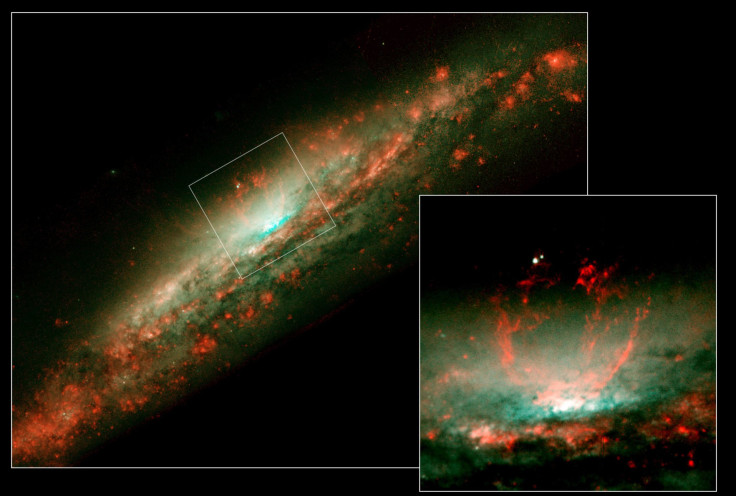NASA Captures 'Superbubbles In Space' In Stunning Image Of Galaxy NGC 3079 [PHOTO]

NASA has found two "superbubbles" in a galaxy 67 million light-years away from Earth.
Bubbles in space are very different from the ones we know. Space bubbles are composed of a lighter gas inside a heavier one, and two such "superbubbles" were discovered stretching out from opposite sides of the galaxy NGC 3079's center, according to NASA's website. One of the bubbles is 4,900 light-years across, while the smaller one measures about 3,600 light-years in diameter. One light-year is around 6 trillion miles (9 trillion kilometers).
NASA shared a composite image of NGC 3079's superbubbles created from data from NASA’s Chandra X-ray Observatory and NASA’s Hubble Space Telescope. The X-ray data from Chandra appears in purple, while the optical data from Hubble are shown in blue and orange. "@chandraxray data combines w/ @NASAHubble optical data to reveal a pair of balloon-like regions in a galaxy 67 million light yrs from Earth," the tweet read.
NASA telescopes were able to detect the NGC 3079 superbubbles due to their X-ray, optical and radio emission, which appears as light.
What’s better than bubbles? Superbubbles in space! @chandraxray data combines w/ @NASAHubble optical data to reveal a pair of balloon-like regions in a galaxy 67 million light yrs from Earth. Learn about superbubbles' possible connection to cosmic rays: https://t.co/ZrZD34SiZw pic.twitter.com/mOwzchlG6F
— NASA (@NASA) March 2, 2019
In a research published in The Astrophysical Journal and led by Jiangtao Li of the University of Michigan, Chandra findings revealed that a cosmic particle accelerator within NGC 3079 is the source of ultra-energetic particles found in the rims of the superbubbles. These objects are believed to be more energetic than the particles produced by the world's most powerful artificial particle accelerator, the Large Hadron Collider (LHC) in Europe.
As for the significance of the discovery of superbubbles, scientists believe that structures such as these are responsible for the "cosmic rays" or high-energy particles that regularly bombard Earth. It was previously found that exploding stars could produce shock waves due to the acceleration of particles up to energies about 100 times larger than those generated in the LHC.
However, researchers had been unsure about what could produce cosmic rays that were even more energetic. But this latest discovery seems to support the idea that superbubbles are one of the sources of these ultra-energetic cosmic rays.
According to NASA's Jet Propulsion Laboratory, the NGC 3079 is about 50 million light-years from our planet and located in the constellation Ursa Major.
© Copyright IBTimes 2025. All rights reserved.





















